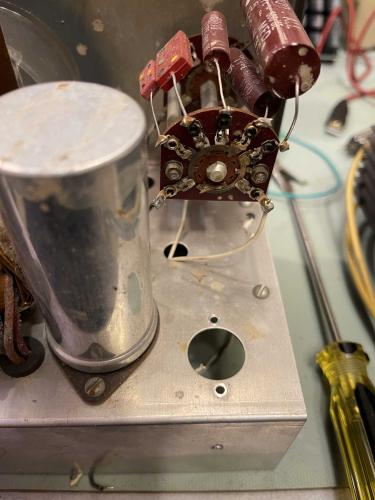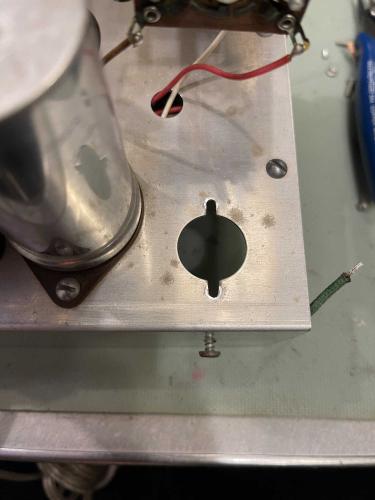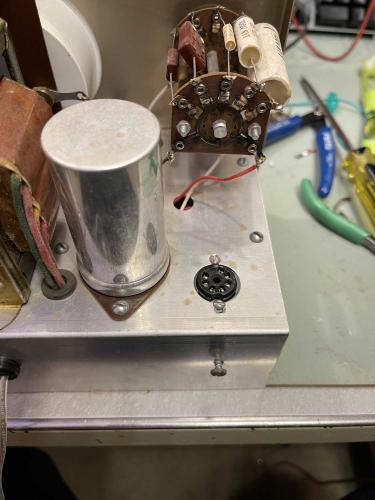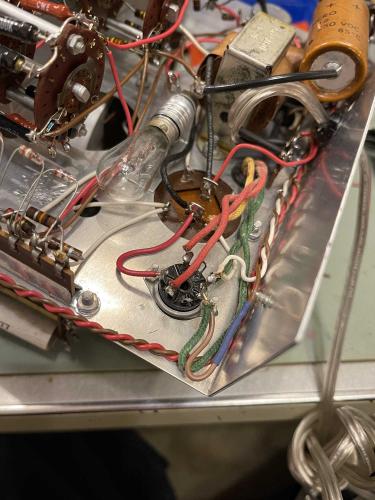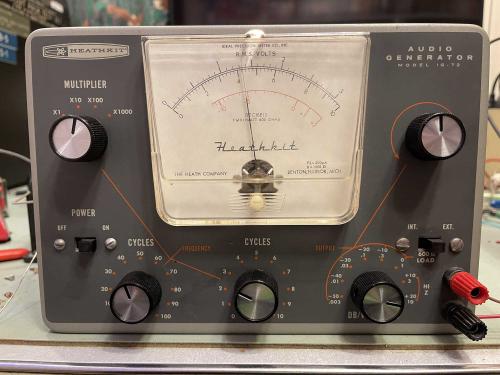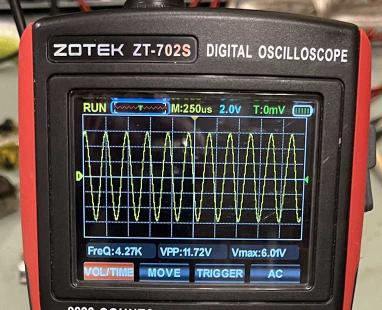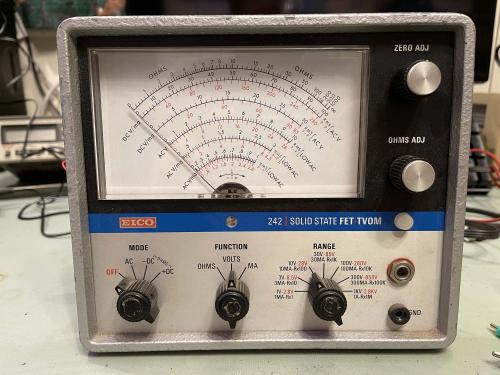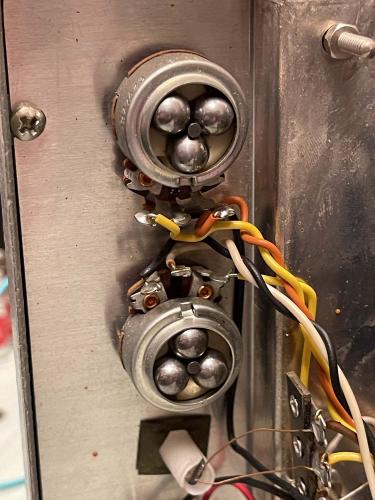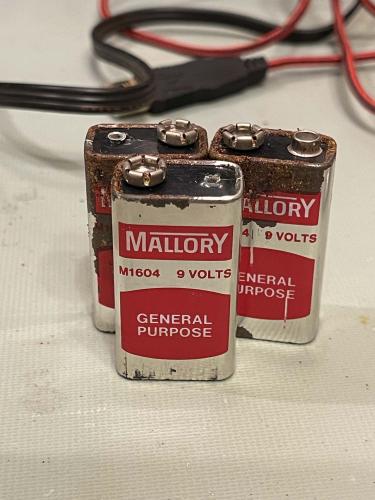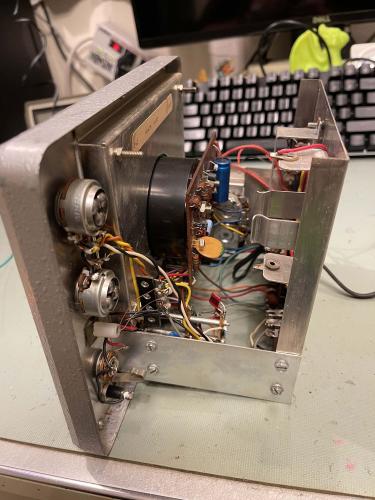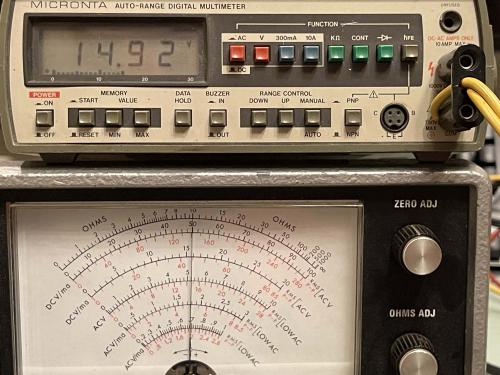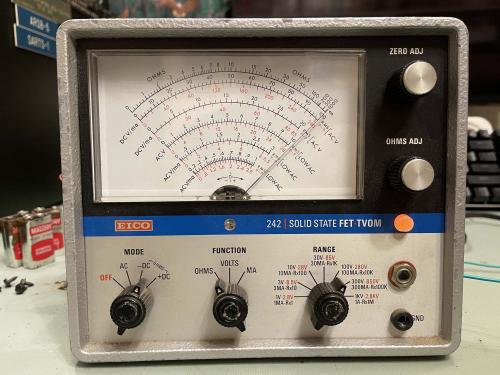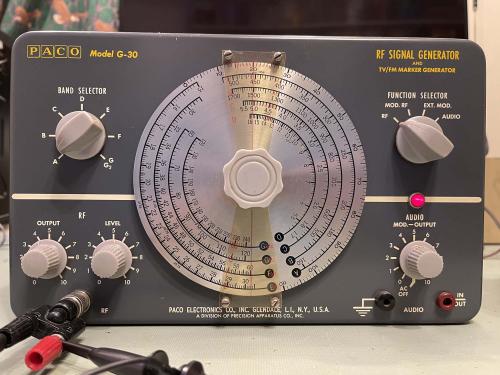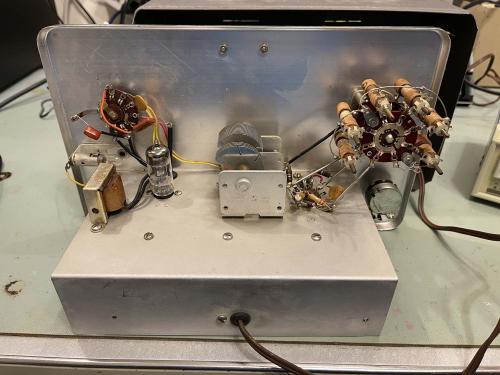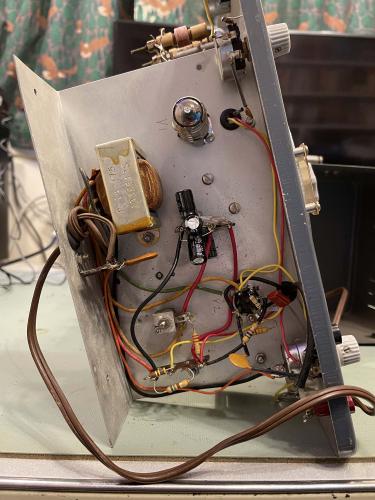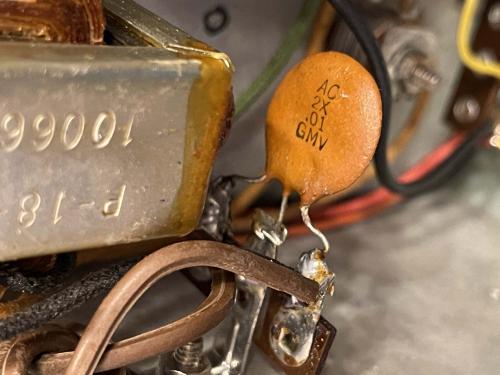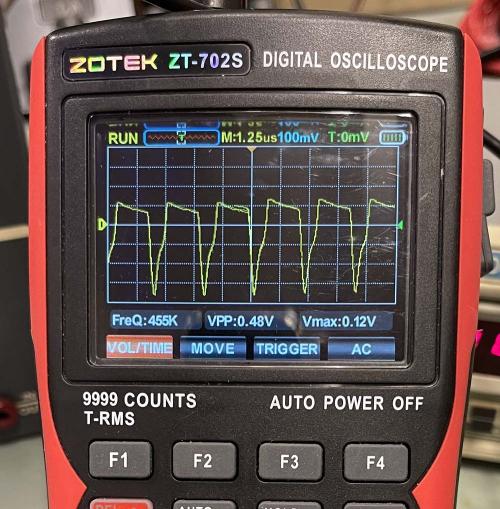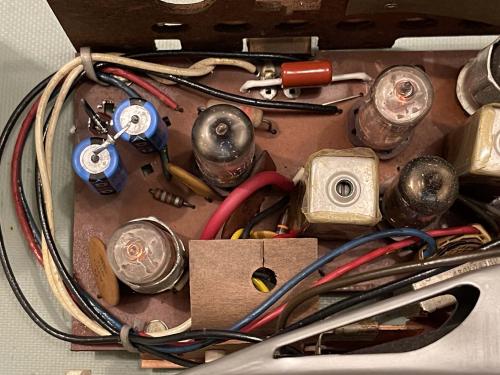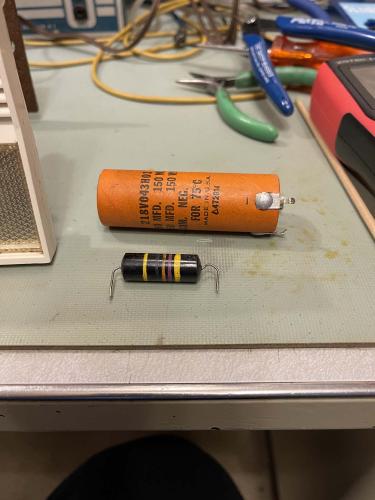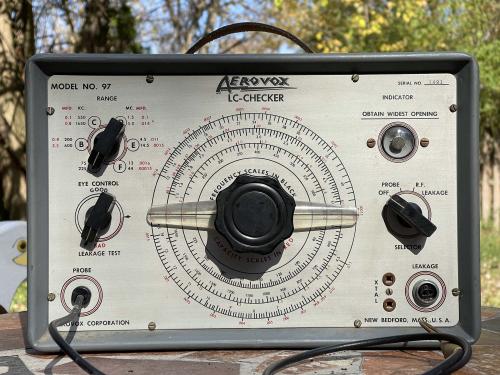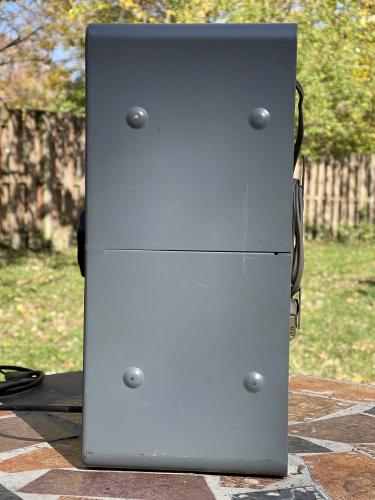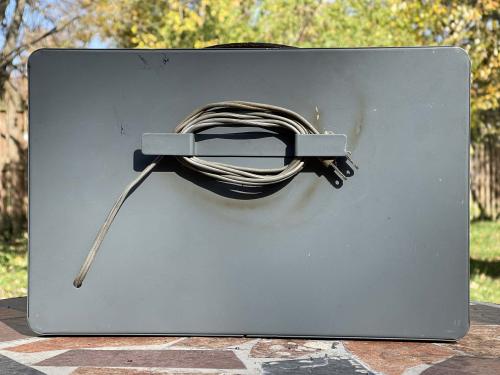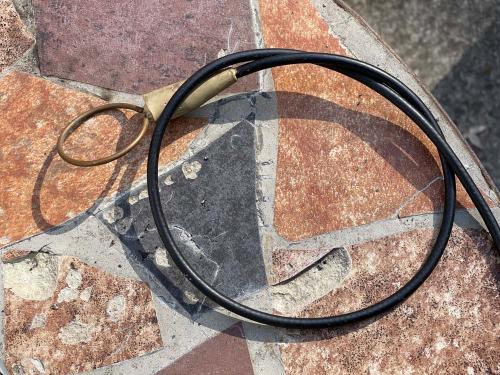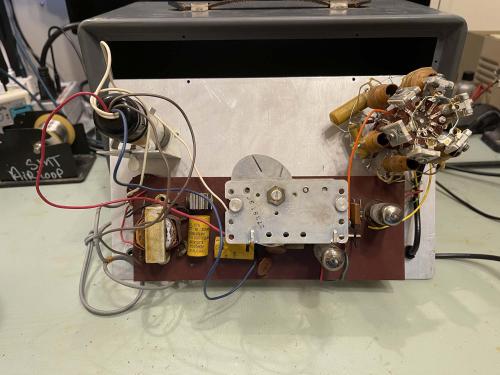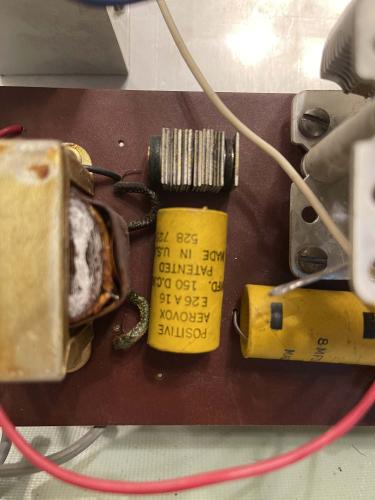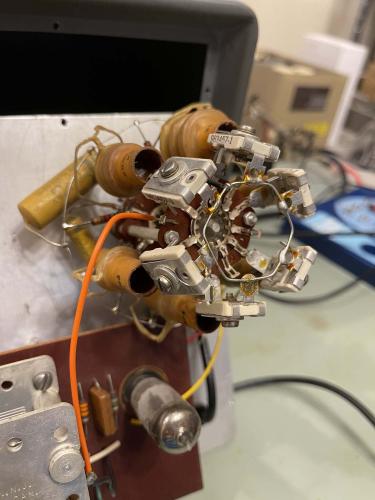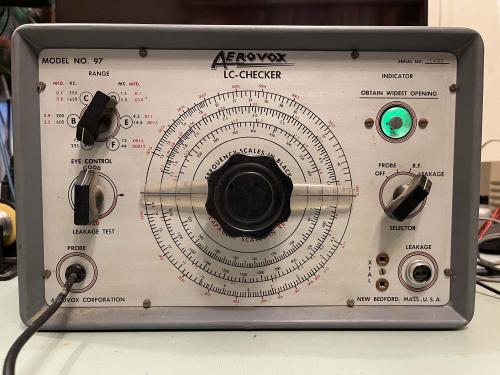- 2024
- Nov
- 5
A Heathkit IG-72 Signal Generator Part 6 - We’re back up and running.
In the last part of this series, I was just getting ready to button up the device when it started arcing across two of the pins on the rectifier tube socket. Carbon tracking is a thing with these older devices, and it’s hard to tell how much flux, solder, dirt, and other grime that this thing has collected over the years, so a tube socket replacement was in order. I measured the centers and ordered some.
Turns out the ones that Heathkit used here are on slightly wider centers than 1”. 1 1/8” maybe? Regardless, I decided to pull the socket out of the one I have as a spare.
I took the bad socket out of the good chassis and noticed something. You’ve probably been screaming this at the screen the whole time, but I apparently chose to stick my head in the mud.
Turns out that, unlike the old chassis, Heathkit slotted the mount holes for sockets on this one. I could have used one of the 7/8” center sockets here. It probably will require some wire extension as the old socket has the pins on a wider diameter, as well as having them splayed out more.
The new socket was installed with minimal issue. It is a little smaller of a hole than it should have, and messing with those small screws was kind of a pain, but it’s there, and secure.
There was less wire manipulation required than I thought. I had to extend the heater wire a bit because some idiot tried to trim it and ended up cutting it instead. (If I find him I’ve got some strong words for him.) Overall, I was able to keep all of the original wire without too much heat damage from soldering/unsoldering.
As with all of these, I try not to cut any transfomer wires back.
What’s the verdict? At first, it was nothing. Aww crap, something’s wrong, but that just turned out to be that big lightbulb had come loose. A quick tighten and:
We now return you to your previously scheduled calibration.
Next part of this series: https://wereboar.com … 7-i-think-were-done/
Previous part of this series: https://wereboar.com … 5-were-not-done-yet/
- 2024
- Nov
- 3
An EICO 242 FET VOM
This device came to me from the Columbus Hamfest, another piece from an estate sale. It’s part of my “I can’t go home without a voltmeter” thing, and I figured it’s small enough that it would make a nice bench “no tubes” meter.
It’s built on EICO’s late model transistor chassis, and features everything you’d expect from a FET VOM. High impedance, a big face, and multiple ranges. Oddly absent is a mirror for parallax error resolution, which seems like it would have been a cheap thing to have. Also odd is EICO’s choice of a phone jack for input. There’s some muttering in the manual about that, but it’s just a gimmick from what I can see. Kind of locks you in to their probes. What’s not good about that is the tip is hot, so if your probe gets pulled out live (or inserted live) you can can hit the ring, which is ground. I need to figure out how to re-make this and make it safe(r).
Some of the parts are quite well made. Take these 10-turn ball-bearing pots. These things turn so smooth.
The device can either run on AC line, or 3 9V batteries and 1 1.5V D-Cell. Sort of.
The D-Cell had been removed, but the 9V batteries were still there.
How long has it been since Mallory made batteries? Long enough that these were coated with carbon-zinc rust. Some of the terminals were corroded into the snaps, which is not a big deal. I don’t expect to use this thing on batteries.
The unit consists of a single board and some parts on strips. It’s really pretty simple, just some differential amps and the FET on the input.
After removing the batteries, I powered it on. DC measurement is off - but there are cal pots inside.
Ohms…that didn’t work. The device stayed on zero and the ohms control did nothing, whereas the zero control slammed the needle to the left. A quick check of the schematic showed something interesting - a 1.5V battery! Turns out this thing NEEDS the 1.5V D-Cell, even when operating off line. I just happened to have one, in it went, and…yep. That works now.
There’s nothing wrong with this save it needs a good warm-up and cal. I’ll probably do that sometime in the next few weeks and get this thing installed on the bench - after I make a probe adapter, of course!
- 2024
- Nov
- 3
A PACO G-30 RF Signal Generator
As with a lot of other things, I picked this signal generator up a few years ago at the Cuyahoga Falls hamfest. I seem to remember the person telling me they were using it up until it was sold, as they were trying to clean out some of the redundant equipment.
(Yes, it’s on. I had already opened it at this point to check on things.}
The device itself looks to consist of an oscillator and an amplifier tube. I assume the amp is on top, and the osc is on the bottom (w/shield) but I won’t know until I check the schematics.
Note the selenium stack. It looks like this device has been rebuilt somewhat recently. I don’t think I would have done the capacitors up like that, but it works well enough.
The person didn’t replace two of the most important things, however:
The first being the power cord, which is just as hard as can be. The second is that little disc thing with three legs. This is a safety capacitor, and is two .01µF capacitors back to back. These tend to blow open, as they physically separate, but it’s still a potential problem. Not sure why this didn’t get replaced, but I have two .01µF film caps @ 630V that would work here. If I decide to put it in service, that is. The output isn’t really pretty.
Before you go “That ain’t right” - it may be. In fact, it is. This device uses harmonics to generate it’s output, so you don’t get a signal like you would with a modern, synthesized unit. This is probably fine for an old AA5 radio. I did note that the frequency per the scope is dead on, so that’s a good start.
Stay tuned, this will probably show up again later as a fix it or forget it post.
Next part of this series: https://wereboar.com … r-part-2-revisiting/
- 2024
- Nov
- 2
A Westinghouse H-636T6 AA5+1 Radio - It lives*
This one was a nice example of a 6 tube AA5 - it has a tuned RF front end which amplifies the RF before it’s brought down to it’s IF signal that the radio demodulates the audio from. That gives it the ability to hear more stations - without any further tuning I was listening to a station 115 miles away during the day, something other radios have a hard time doing during the quieter night period.
Radio came to me not working, seller said “Won’t warm up.” I think the guy just didn’t know that the power was pull on, not turn on. Plugged it in, and bad filters - the characteristic loud 60Hz buzz said that immediately. The replacements are the two cylinders standing up in the upper right corner. Two 47μF @ 160V replaced the 40/40@150 there previously. That device was dead, high ESR and loss, and cracked potting.
That brought the radio back to life, but the across-the-line capacitor had to be changed as well. That’s a .047μF @ 630V that literally sits across the AC line, and helps reduce noise in the system. That’s the orange-red rectangle in the middle, a brand new film cap with it’s leads covered in spaghetti to keep it off of the AC below.
These go bad just because they have a lot of voltage on them, and age - the part in there was a type of capacitor called a bumblebee. They’re BumbleBombs now because they like to pop. Fine for the time, but they crack and leak and get moisture in the paper capacitor material, and go boom.
The radio with all of its new parts. I tried to not disturb anything else. (That recent spaghetti purchase has been used a lot!)
Here’s the old parts. The bumblebee measured ok, but I didn’t do leakage. The electrolytic was dead, however. Notice how the leads on the ‘bee are bent weird? That’s how it was in the circuit. Someone hand-inserted the part decades ago and said “eh…good enough!”
The only thing it really needs at this point is a little bit of penetrating oil on the tuner, as it’s gritty - a flush clean with DeOxit helped, but some Kroil is in order here. It probably needs an alignment, not a big deal but that’s after the tuner is cleaned, and it needs the dial lamps replaced. Power cord could be changed as well, but since it’s one of those in-the-case style it’s going to need a bit of doing. I may just solder a new cord in the board and run it out the hole.
In all, it was a good find in my opinion, a nice clean example of a AA5, late enough that silver mica disease hasn’t taken over yet. It’s getting harder to find this kind of radio in good shape, so as soon as the lubricant arrives and I get it tuned up, it goes on the shelf in the living room for use.
I don’t know that there will be much for a third part, except to talk about how far off the alignment is. We’ll see, stay tuned!
Next part of this series: Coming evenutally.
Previous part of this series: https://wereboar.com … -h-636t6-aa51-radio/
- 2024
- Nov
- 2
The Aerovox Model 97 LC-Checker
This interesting piece came from the 2024 Cleveland Hamfest for $5. The vendor was selling an estate - that seems to be happening a lot lately - and was just looking to return some cash to the estate itself. He knew nothing about the unit, but I took a chance and picked it up.
Aerovox, of course, is a name you’ll probably see on capacitors in older devices. The name Aerovox is still out there, but it seems to be more of an industrial player instead of a consumer devices company.
The device seems to be fairly standard at first glance, with your normal ranges and dial to tune to the unit under test.
Nothing special about the case.
The back does have a nice cord wrap area, and the cord seems to be still soft.
The probe is the most unusual part of this device, and is a deal-breaker for using the thing.
Its an inductive probe - there was another piece that went inside this loop of copper, so you could make a part connection without actually connecting the electronics of the tester to the part itself. This is kind of cool because it avoids hitting a live or charged device, but it’s also missing the business end of the probe, so the device can’t read anything. I’m sure it could be modified to work, but I have enough checkers already…
The inside is pretty sparse. A big selenium stack, some capacitors, and the oscillator section for actually checking parts. The big banana slicer in the middle dominates everything.
The device does come alive, and switching things makes the eye open and close.
But…that’s about it. Without the probe, it’s nothing more than a shelf queen - or parts. Fortunately, I have someone who would like a display piece, so it goes to them instead of the parts bin.
